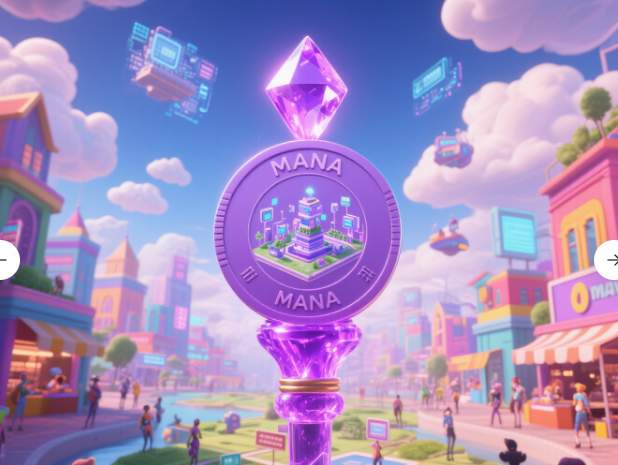As the metaverse continues to mature, MANA, the native token of Decentraland, has become a focal point in discussions surrounding digital ownership
As the metaverse continues to mature, MANA, the native token of Decentraland, has become a focal point in discussions surrounding digital ownership, virtual real estate, and decentralized economies. But as user interest fluctuates and skepticism around the metaverse grows, investors and tech observers alike are asking: Is MANA still a viable investment, or has the hype faded?
A Virtual World with Tangible Economics
Decentraland positions itself as a fully decentralized virtual world where users can buy, develop, and monetize parcels of land using MANA. Unlike traditional gaming platforms, all assets in Decentraland are represented by non-fungible tokens (NFTs) on the Ethereum blockchain, enabling real ownership.
A report by Grayscale Investments (2021) estimated that the metaverse market could generate annual revenues of over $1 trillion, driven by social commerce, digital events, and real estate speculation. Within this ecosystem, MANA is essential for transactions and governance, cementing its place as the economic engine of Decentraland.
The Pitfall of Low User Retention
Despite the optimism, Decentraland has faced scrutiny for its low daily active users. According to DappRadar, the platform saw as few as 38 active users per day in Q3 2023, sparking debates about its relevance. However, this figure was often misunderstood, as DappRadar only tracks wallet interactions with smart contracts, not total in-world activity.
That said, user engagement remains a major challenge. Search interest reveals that many potential users are Googling terms like:
“Is Decentraland worth it?”
“How to make money in MANA?”
“Why is MANA dropping?”
These searches reveal key pain points: utility confusion, profit uncertainty, and price volatility.

Real Use Cases: Beyond Just Speculation
Where MANA shines is in its experimental, decentralized model for digital society. Major brands like Samsung, Adidas, and JP Morgan have launched virtual spaces in Decentraland, signaling institutional interest. The Metaverse Fashion Week held in Decentraland in 2022 drew global attention, showcasing how events can bridge real and digital worlds.
More importantly, MANA holders participate in Decentraland DAO governance, voting on policy updates, land auctions, and development grants. This level of democratic participation is rarely seen in mainstream platforms.
Still, the question lingers: Is this enough to sustain long-term growth?
MANA's Price Behavior and Investor Insights
Data from CoinGecko shows that MANA hit its all-time high of $5.85 in November 2021, fueled by the metaverse boom. Since then, it has retraced significantly, trading around $0.40–$0.50 as of mid-2025. Volatility remains high, reflecting macroeconomic uncertainty and crypto market cycles.
However, a 2024 report by Messari highlighted that tokens like MANA, which are tied to user-governed ecosystems, may outperform in the long run due to strong community incentives and real-world utility.
Still, risks remain. Ethereum gas fees, onboarding friction, and a steep learning curve all deter mainstream adoption. For MANA to scale, Decentraland needs to streamline UX and offer clearer pathways to value creation.
How to Evaluate MANA Today: Utility vs. Speculation
So, how should one approach MANA in 2025?
If you're looking for short-term speculative gains, MANA may not deliver unless a major event boosts metaverse sentiment.
If you're a believer in decentralized virtual economies, MANA offers a rare opportunity to shape a digital civilization—complete with governance, identity, and capital.
Strong community support, ongoing development, and big-brand partnerships continue to give MANA a unique edge. But as always, DYOR—do your own research.
In Summary
MANA represents a bold vision of how digital economies can be governed by users, not corporations. Despite current adoption hurdles, its foundation—rooted in decentralization, ownership, and participatory governance—makes it more than just a virtual currency. It's a bet on the future of the internet.
Explore more crypto insights at coin78, your trusted source for exchange news and blockchain trends.
About the Author
Alex Renner is a digital asset researcher and fintech strategist with over 8 years of experience in blockchain infrastructure, DeFi protocols, and token economics. He has contributed to multiple industry reports on the metaverse, including analysis for institutional clients in Europe and Asia. His focus lies in decoding emerging crypto narratives and making them actionable for retail and professional investors alike.
1. The information content does not constitute investment advice, investors should make independent decisions and bear their own risks
2. The copyright of this article belongs to the original author, and only represents the author's personal views, not the views or positions of Coin78. This article comes from news media and does not represent the views and positions of this website.
 USD
USD CNY
CNY HKD
HKD TWD
TWD VND
VND USDT
USDT